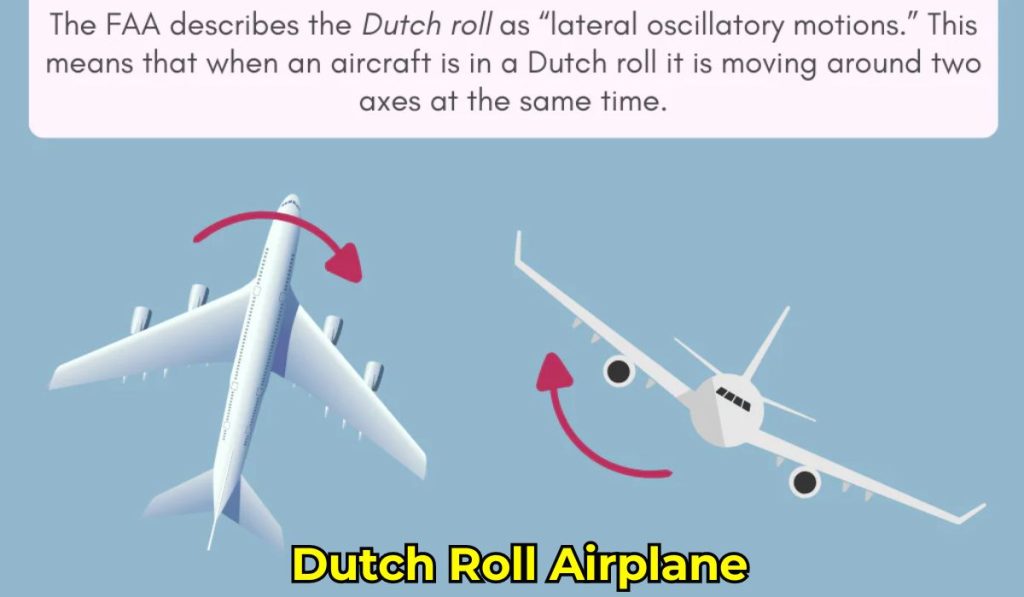
Have you ever been on a flight where the plane seemed to develop a rhythmic side-to-side rocking motion, accompanied by a slight yaw (nose movement)? If so, you might have experienced a phenomenon known as Dutch roll. While it can be unsettling for passengers, Dutch roll is a well-understood flight dynamic and is usually well-managed by modern aircraft design and pilot training.
Demystifying A Technical Breakdown of Dutch Roll
Dutch roll is an oscillatory motion that combines yaw (the airplane’s nose moving left and right) and roll (the airplane’s wings tilting from side to side) in an out-of-phase manner. Imagine a see-saw tilting to one side while also slightly swaying back and forth – that’s the basic idea of Dutch roll. This motion typically occurs at a frequency of 1-2 cycles per second, lasting for several cycles before dampening out.
Here’s a deeper dive into the mechanics:
- Lateral and Directional Stability: Dutch roll arises from an imbalance between an airplane’s lateral stability (resistance to rolling) and directional stability (resistance to yawing). When an external disturbance upsets the aircraft (air turbulence, pilot input), these stability forces come into play.
- The Cycle Begins: Let’s say the airplane rolls slightly to one side. Due to lateral stability, the aircraft naturally wants to correct this roll and return to level flight.
- The Wobble Amplifies: However, this correction might overshoot, causing the airplane to roll in the opposite direction. Now, the directional stability kicks in, trying to yaw the nose back towards the original heading.
- The Out-of-Phase Dance: The problem lies in the timing of these forces. The yaw correction might lag behind the roll correction, creating an out-of-phase oscillation. This back-and-forth between roll and yaw is the essence of Dutch roll.
Factors Influencing Dutch Roll
Several factors can influence the likelihood and severity of Dutch roll:
- Aircraft Design: Swept-wing airplanes are generally more prone to Dutch roll due to the way they generate lift at different angles of attack. The vertical stabilizer (tail fin) plays a crucial role in maintaining directional stability and mitigating Dutch roll.
- Altitude and Airspeed: Dutch roll is more likely to occur at higher altitudes and lower airspeeds. This is because the air becomes thinner at higher altitudes, reducing the effectiveness of control surfaces.
- Autopilot Engagement: Modern autopilots often incorporate yaw dampers that automatically apply corrective rudder inputs to counteract Dutch roll tendencies.
Also Read: SpaceX Starship Launch – 4th Test Flight Of The World’s Most Potent Rocket, Nail-Biting Experience
Pilot Techniques for Managing Dutch Roll
While Dutch roll can be unsettling for passengers, it’s important to remember that trained pilots have the skills and knowledge to manage it. Here are some common techniques:
- Rudder Inputs: Pilots can use small rudder inputs to counter the yawing motion and prevent the oscillation from amplifying.
- Aileron Adjustments: In some cases, slight aileron inputs (control surfaces on the wings) can be used to dampen the rolling motion.
- Maintaining Airspeed: Maintaining a safe and appropriate airspeed helps ensure better control authority and reduces the likelihood of Dutch roll.
Mechanics of Dutch Roll
Dutch roll is a lateral-directional oscillation involving both yaw (side-to-side motion) and roll (banking motion). This phenomenon typically occurs in aircraft with swept wings, where aerodynamic forces and moments interact in a way that causes the aircraft to oscillate. When an aircraft yaws to one side, the outer wing moves faster through the air than the inner wing, generating more lift and causing the aircraft to roll in the opposite direction. This rolling motion then induces a yaw in the opposite direction, perpetuating the cycle.
Interesting Story: Airline Employee Killed by Jet Engine “Climbed In Himself” – Police Claims
Causes of Dutch Roll
Several factors contribute to Dutch roll:
- Swept Wings: Aircraft with swept wings are more susceptible due to the aerodynamic characteristics of the wing design.
- Dihedral Effect: The dihedral angle of the wings, where the wings are angled upward from the root to the tip, influences the stability and can exacerbate Dutch roll.
- Yaw Dampers: Insufficient or malfunctioning yaw dampers, which are designed to counteract yawing motions, can lead to pronounced Dutch roll.
- Airframe Design: The overall design and aerodynamic properties of the aircraft play a significant role in its susceptibility to Dutch roll.
Historical Context: Dutch Roll in Aviation
Early Observations
The phenomenon of Dutch roll was first observed in the early days of jet aviation. As aircraft designs evolved to include swept wings for improved performance, pilots and engineers noticed the oscillatory behavior. The term “Dutch roll” itself is believed to be derived from the Dutch style of ice skating, which involves a similar side-to-side motion.
Notable Incidents
Several notable incidents in aviation history have highlighted the significance of Dutch roll. One such incident involved a Boeing 707 in the 1950s, where the crew experienced severe Dutch roll due to a malfunctioning yaw damper. The incident underscored the importance of understanding and mitigating this phenomenon in commercial aviation.
Technological Advancements: Mitigating Dutch Roll
Yaw Dampers
Yaw dampers are crucial in modern aircraft to counteract yawing motions and prevent Dutch roll. These systems use gyroscopic sensors to detect yaw and automatically apply rudder inputs to stabilize the aircraft. Advances in yaw damper technology have significantly improved the safety and comfort of flight, especially in larger, swept-wing aircraft.
Read More: Malaysia Airlines Flight 370 Google Maps
Fly-by-Wire Systems
Fly-by-wire technology, which replaces traditional mechanical flight controls with electronic systems, has enhanced the ability to control Dutch roll. These systems allow for more precise and rapid control inputs, reducing the likelihood and severity of oscillations.
Design Improvements
Aircraft manufacturers continuously refine airframe designs to minimize susceptibility to Dutch roll. This includes optimizing wing sweep angles, dihedral angles, and overall aerodynamic properties. Computational fluid dynamics (CFD) and wind tunnel testing play a crucial role in these design improvements.
